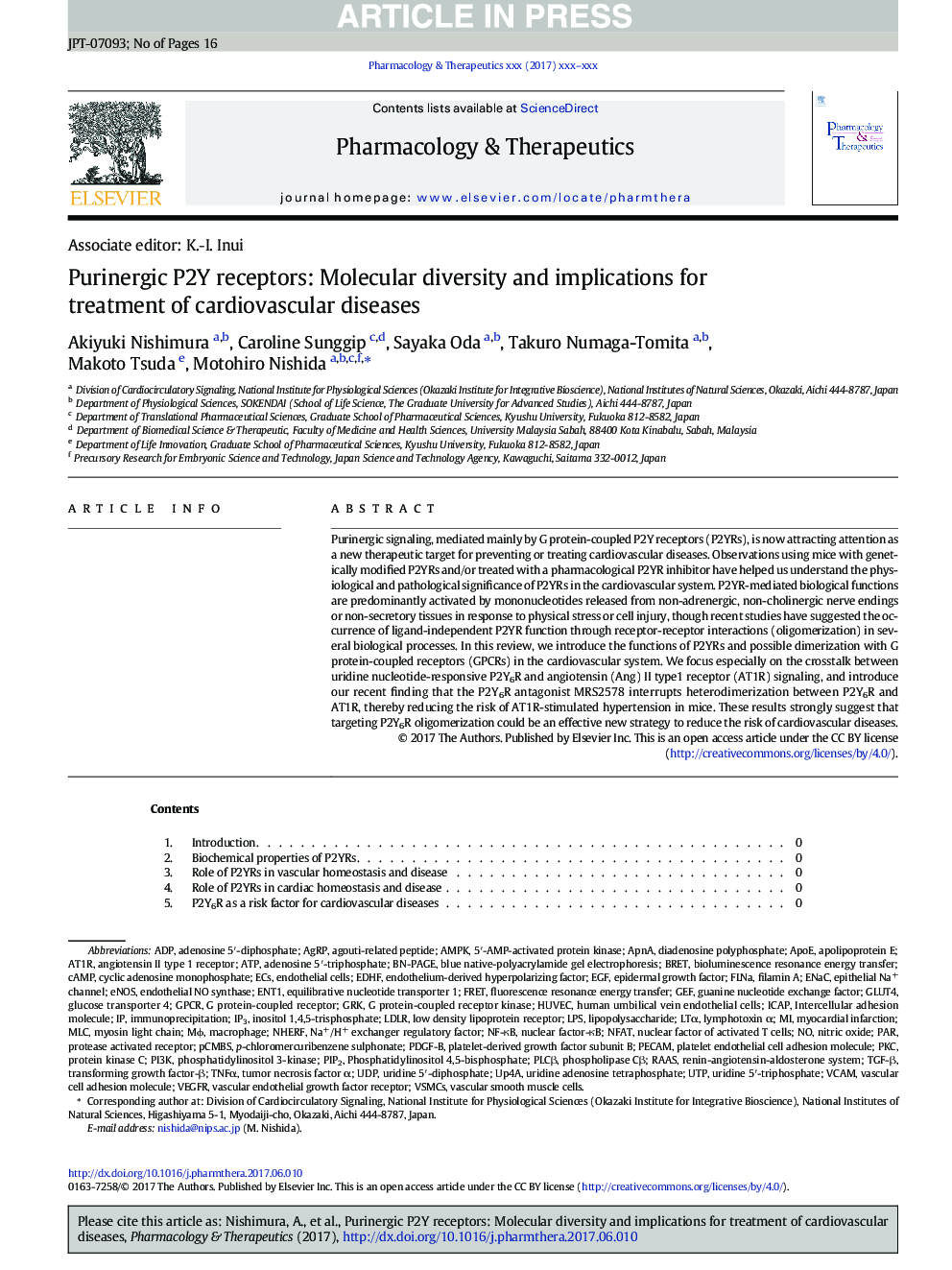| Article ID | Journal | Published Year | Pages | File Type |
|---|---|---|---|---|
| 8537003 | Pharmacology & Therapeutics | 2017 | 16 Pages |
Abstract
Purinergic signaling, mediated mainly by G protein-coupled P2Y receptors (P2YRs), is now attracting attention as a new therapeutic target for preventing or treating cardiovascular diseases. Observations using mice with genetically modified P2YRs and/or treated with a pharmacological P2YR inhibitor have helped us understand the physiological and pathological significance of P2YRs in the cardiovascular system. P2YR-mediated biological functions are predominantly activated by mononucleotides released from non-adrenergic, non-cholinergic nerve endings or non-secretory tissues in response to physical stress or cell injury, though recent studies have suggested the occurrence of ligand-independent P2YR function through receptor-receptor interactions (oligomerization) in several biological processes. In this review, we introduce the functions of P2YRs and possible dimerization with G protein-coupled receptors (GPCRs) in the cardiovascular system. We focus especially on the crosstalk between uridine nucleotide-responsive P2Y6R and angiotensin (Ang) II type1 receptor (AT1R) signaling, and introduce our recent finding that the P2Y6R antagonist MRS2578 interrupts heterodimerization between P2Y6R and AT1R, thereby reducing the risk of AT1R-stimulated hypertension in mice. These results strongly suggest that targeting P2Y6R oligomerization could be an effective new strategy to reduce the risk of cardiovascular diseases.
Keywords
LTαRAASPLCβIP3GPCRPKCAT1RBN-PAGEAMPKUTPGRKVCAMPDGF-BVEGFRPECAMGEFGLUT4MLCVSMCspCMBSENT1EDHFICAPUDPFLNAPIP2NHERFTGF-βApnAlymphotoxin αNa+/H+ exchanger regulatory factorADPNF-κBPI3KEGFeNOSTNFαLPSNFATHUVECAgRPLDLRcAMPECsENaCG protein-coupled receptor kinaseinositol 1,4,5-trisphosphateMϕuridine 5′-diphosphateuridine 5′-triphosphateadenosine 5′-triphosphateadenosine 5′-diphosphateATPCyclic adenosine monophosphateMyocardial infarctionangiotensin II type 1 receptorApoeapolipoprotein Eblue native-polyacrylamide gel electrophoresisFluorescence resonance energy transferbioluminescence resonance energy transferFRETendothelial NO synthaseBRETtransforming growth factor-βImmunoprecipitationPartumor necrosis factor αglucose transporter 4Filamin Amyosin light chainHuman umbilical vein endothelial cellsVascular smooth muscle cellsEndothelial cellsRenin-angiotensin-aldosterone systemepidermal growth factorNuclear Factor of Activated T Cellsguanine nucleotide exchange factornuclear factor-κBEndothelium-derived hyperpolarizing factorPhosphatidylinositol 3-kinasephosphatidylinositol 4,5-bisphosphatePhospholipase CβlipopolysaccharideMacrophageintercellular adhesion moleculeplatelet endothelial cell adhesion moleculevascular cell adhesion moleculeNitric oxideprotease activated receptor5′-AMP-activated protein KinaseProtein kinase Cdiadenosine polyphosphateagouti-related peptideEpithelial Na+ channelvascular endothelial growth factor receptorlow density lipoprotein receptorG protein-coupled receptor
Related Topics
Health Sciences
Pharmacology, Toxicology and Pharmaceutical Science
Pharmacology
Authors
Akiyuki Nishimura, Caroline Sunggip, Sayaka Oda, Takuro Numaga-Tomita, Makoto Tsuda, Motohiro Nishida,
